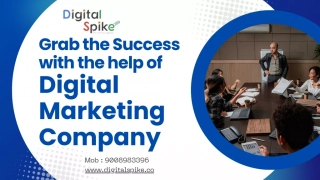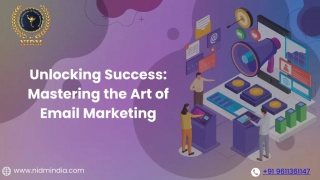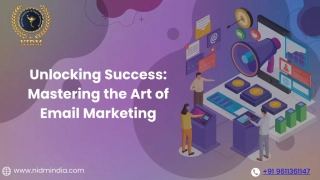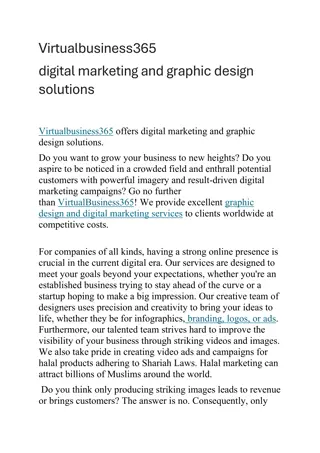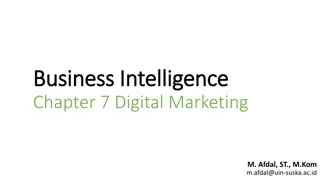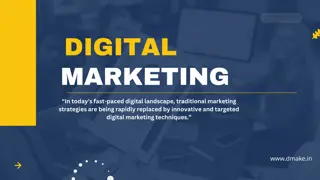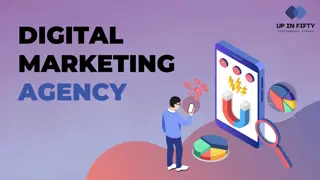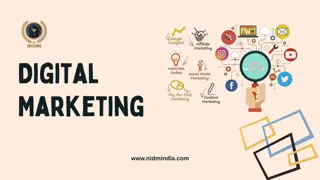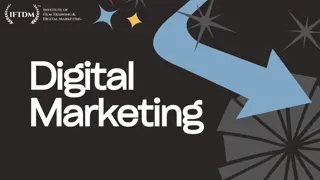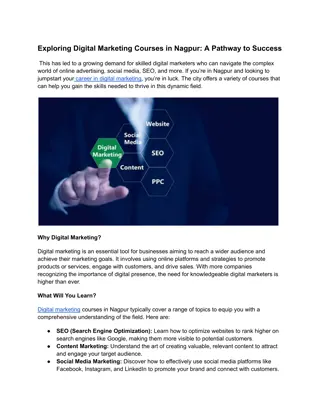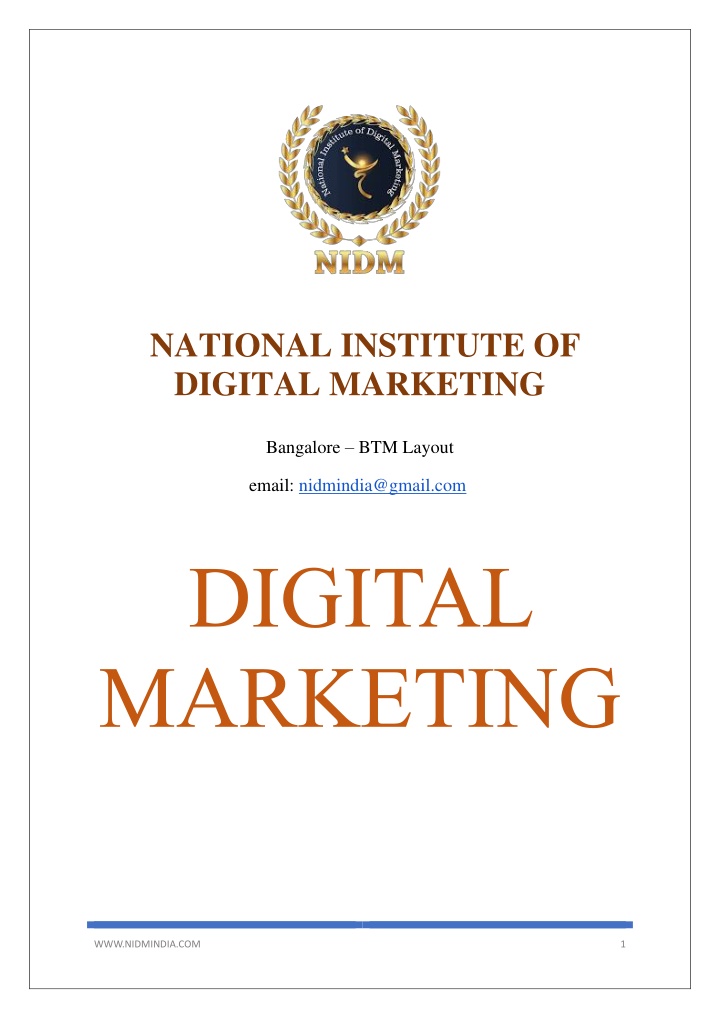
DIGITAL MARKETING
Digital marketing refers to the practice of promoting products, services, or brands using digital channels and technologies. It encompasses a wide range of online marketing activities aimed at reaching and engaging customers in the digital environment. As internet usage continues to grow, digital marketing has become a crucial component of modern business strategies.nnwww.nidmindia.com
Download Presentation

Please find below an Image/Link to download the presentation.
The content on the website is provided AS IS for your information and personal use only. It may not be sold, licensed, or shared on other websites without obtaining consent from the author. If you encounter any issues during the download, it is possible that the publisher has removed the file from their server.
You are allowed to download the files provided on this website for personal or commercial use, subject to the condition that they are used lawfully. All files are the property of their respective owners.
The content on the website is provided AS IS for your information and personal use only. It may not be sold, licensed, or shared on other websites without obtaining consent from the author.
E N D
Presentation Transcript
NATIONAL INSTITUTE OF DIGITAL MARKETING Bangalore BTM Layout email: nidmindia@gmail.com DIGITAL MARKETING WWW.NIDMINDIA.COM 1
INDEX: Module 1: Introduction to Digital Marketing . 3 - 6 Module 2: Website Planning and Development . 7 - 8 Module 3: Search Engine Optimization (SEO) ... 9 - 11 Module 4: Content Marketing 11 - 13 Module 5: Social Media Marketing . 13 - 14 Module 6: Pay-Per-Click Advertising (PPC) 15 - 16 Module 7: Email Marketing . 16 - 17 Module 8: Affiliate Marketing .17 - 18 Module 9: Online Reputation Management (ORM) .18 - 19 Module 10: Analytics and Reporting . 19 - 20 Module 11: Advanced Digital Marketing Techniques . 20 21 Conclusion . 22 Reference 23 WWW.NIDMINDIA.COM 2
INTRODUCTION What is Digital Marketing? Digital marketing refers to the use of digital channels, platforms, and technologies to promote products, services, or brands. Unlike traditional marketing, which relies on mediums such as print, television, and radio, digital marketing leverages the internet and electronic devices to reach a global audience. The core objective is to connect with customers in the right place and at the right time. Importance of Digital Marketing: In today's digitally connected world, digital marketing has become essential for businesses of all sizes. Here are some key reasons why digital marketing is crucial: 1.Wider Reach: Digital marketing allows businesses to reach a broader audience across geographical boundaries. Through online platforms, companies can engage with potential customers globally, breaking the limitations of physical presence. 2.Cost-Effective: Compared to traditional marketing, digital marketing often offers a higher return on investment (ROI). Small businesses can compete with larger companies by strategically using cost-effective digital marketing tactics such as social media marketing and email campaigns. 3.Targeted Advertising: Digital marketing enables precise targeting of specific demographics, interests, and behaviors. Tools like Google Ads and Facebook Ads allow businesses to create highly targeted campaigns, ensuring that their messages reach the most relevant audience. WWW.NIDMINDIA.COM 3
4.Measurable Results: One of the biggest advantages of digital marketing is the ability to measure and analyze results in real time. Analytics tools provide detailed insights into campaign performance, customer behavior, and conversion rates, helping businesses refine their strategies for better outcomes. 5.Engagement and Interaction: Digital platforms provide opportunities for two-way communication between businesses and customers. Social media, for instance, allows brands to interact directly with their audience, respond to queries, gather feedback, and build relationships. History and Evolution of Digital Marketing: The history and evolution of digital marketing is a fascinating journey that has transformed the way businesses promote their products and services. Digital marketing emerged as a result of the rapid growth and adoption of the internet and digital technologies. Here's an overview of its development: 1.The Early Days (1990s) The advent of the World Wide Web in the 1990s marked the beginning of digital marketing. Early digital marketing efforts were primarily focused on creating basic websites and utilizing email marketing to reach potential customers. This period saw the emergence of search engines like Yahoo and Google, which opened up new avenues for online advertising and search engine optimization (SEO). 2.The Rise of Social Media (2000s) The 2000s witnessed the birth and rapid growth of social media platforms like Facebook, Twitter, and LinkedIn. These platforms revolutionized digital marketing by providing businesses with new channels to connect with their target audiences, build brand awareness, and engage with customers. Social media marketing became a crucial component of digital marketing strategies. 3.Mobile Revolution (Late 2000s and 2010s) The widespread adoption of smartphones and mobile devices in the late 2000s and 2010s led to a significant shift in digital marketing. Businesses had to adapt their strategies to cater to mobile users, leading to the development of responsive web design, mobile apps, and mobile advertising. This period also saw the rise of location-based marketing and the integration of mobile into overall digital marketing campaigns. 4.Content Marketing and Influencer Marketing (2010s) As the digital landscape became more competitive, content marketing emerged as a powerful strategy for attracting and engaging audiences. Businesses started creating valuable and relevant content, such as blog posts, videos, and infographics, to establish their expertise and build trust with their target audience. Additionally, influencer marketing gained prominence, with businesses collaborating with influential individuals on social media platforms to reach wider audiences. 5.Artificial Intelligence and Automation (2010s and beyond) The integration of artificial intelligence (AI) and machine learning into digital marketing has significantly increased the efficiency and personalization of campaigns. AI-powered tools can analyze vast amounts of data, provide insights into customer behavior, and automate tasks like ad targeting, content optimization, and personalized recommendations. This WWW.NIDMINDIA.COM 4
has enabled businesses to deliver more relevant and tailored experiences to their customers. 6.Omnichannel Marketing (Present and Future) As consumers engage with brands across multiple channels and devices, omnichannel marketing has become crucial. This approach ensures a seamless and consistent brand experience by integrating various digital and offline channels, such as websites, social media, email, mobile apps, and physical stores. The goal is to provide a cohesive and personalized customer journey across all touchpoints. The evolution of digital marketing continues to accelerate, driven by technological advancements, changing consumer behavior, and the ever-increasing demand for personalized and engaging experiences. As new technologies emerge, such as virtual and augmented reality, the Internet of Things (IoT), and advanced analytics, digital marketing strategies will continue to evolve to keep pace with these developments. Digital vs. Traditional Marketing: Digital marketing and traditional marketing are two distinct approaches to promoting products and services, each with its own strengths and limitations. Here's a comparison between the two. Digital Marketing: 1.Reach: Digital marketing has a global reach, allowing businesses to target audiences worldwide through platforms like social media, search engines, and websites. 2.Measurability: Digital marketing campaigns are highly measurable, providing detailed analytics on metrics such as website traffic, click-through rates, conversion rates, and return on investment (ROI). WWW.NIDMINDIA.COM 5
3.Personalization: Digital marketing allows for personalized and targeted messaging based on user data, behavior, and preferences, enabling more effective and relevant communication with customers. 4.Cost-effectiveness: Compared to traditional marketing, digital marketing can be more cost-effective, especially for small businesses and startups, as it eliminates the need for expensive advertising spaces or print materials. 5.Interactivity: Digital channels enable two-way communication and interaction with customers, fostering engagement and building relationships. 6.Agility: Digital marketing campaigns can be quickly adapted and adjusted based on real-time data and feedback, allowing for greater flexibility and responsiveness. Traditional Marketing: 1.Physical Presence: Traditional marketing tactics, such as billboards, print advertisements, and TV commercials, have a physical presence that can create a lasting impression and reach audiences who may not be actively seeking information online. 2.Brand Awareness: Traditional marketing methods are effective for building brand awareness and establishing a brand's identity in the minds of consumers. 3.Credibility: Some audiences may perceive traditional marketing as more credible and trustworthy, especially for established brands or industries. 4.Tangibility: Physical marketing materials, like brochures or product samples, can provide a tactile experience that can be more memorable for some consumers. 5.Targeting: Traditional marketing channels often target specific geographic areas or demographics, allowing for more focused campaigns. 6.Limited Measurability: While some traditional marketing efforts can be measured (e.g., coupon redemptions, toll-free numbers), it can be challenging to accurately track and attribute success to specific campaigns. It's important to note that the most effective marketing strategies often involve a combination of digital and traditional tactics, tailored to the specific goals, target audience, and industry of a business. Many companies adopt an integrated marketing approach, leveraging the strengths of both digital and traditional marketing to maximize their reach, engagement, and overall effectiveness. The choice between digital and traditional marketing, or a blend of both, depends on factors such as the target audience, budget, campaign objectives, and the nature of the product or service being promoted. WWW.NIDMINDIA.COM 6
Website Planning and Development: Website Basics: Building an effective website is crucial for businesses and organizations in the digital age. A well-designed website can serve as a powerful marketing tool, improve brand visibility, and enhance customer engagement. By incorporating these website basics, businesses can establish a strong online presence, improve user experience, and effectively communicate their brand message to potential customers. Additionally, a well-designed and optimized website can serve as a powerful lead generation and conversion tool, contributing to the overall success of your digital marketing efforts. Domain and Hosting: These are two essential components for establishing an online presence and launching a website. Here's an overview of each: Domain: A domain is the unique address or URL (Uniform Resource Locator) that identifies a website on the internet. It typically consists of two parts: the website name (e.g., example) and the top-level domain (e.g., .com, .org, .net). When someone enters your domain into a web browser, they are directed to your website. Web Hosting: Web hosting is the service that provides storage space and online connectivity for your website files, making them accessible on the internet. When someone visits your domain, the web hosting server retrieves and delivers the website content to their browser. Website Design and Development: WWW.NIDMINDIA.COM 7
Website Design is the process of creating and building a website from scratch or redesigning an existing one. It involves various aspects, including visual design, user experience (UX), content creation, and technical implementation. Website design and development often involve collaboration between various professionals, including designers, developers, content creators, and project managers. The process can be iterative, with continuous refinements based on user feedback and changing requirements. Effective website design and development strike a balance between aesthetics, usability, and functionality, ensuring that the website meets the goals and expectations of both the business and its target audience. User Experience (UX) and User Interface (UI): User Experience (UX) and User Interface (UI) are closely related but distinct concepts in the field of website and application design. User Experience (UX): User Experience (UX) refers to the overall experience a person has while interacting with a product, system, or service. It encompasses all aspects of the user's interaction, including the practical, experiential, affective, meaningful, and valuable aspects. UX design focuses on creating products and interfaces that are intuitive, efficient, and enjoyable to use. User Interface (UI): The User Interface (UI) is the visual and interactive component of a product or application. It is the tangible manifestation of the UX design and serves as the medium through which users interact with the underlying system or functionality. Mobile Responsiveness: It refers to the ability of a website or web application to adapt and provide an optimal viewing and interaction experience across different devices and screen sizes, particularly on mobile devices such as smartphones and tablets. With the increasing use of mobile devices to access the internet, it has become crucial for websites and applications to be designed and developed with mobile responsiveness in mind. A responsive design ensures that the content, layout, and functionality of a website or app adjust automatically to the screen size and resolution of the device being used, providing a seamless and user-friendly experience. WWW.NIDMINDIA.COM 8
Search Engine Optimization (SEO): Engine Optimization (SEO): is the practice of optimizing websites and web pages to rank higher in search engine results for relevant keywords and phrases. The primary goal of SEO is to improve a website's visibility and organic (non- paid) traffic from search engines like Google, Bing, and Yahoo. SEO is an ongoing process that requires consistent effort and adaptation to search engine algorithm updates and industry best practices. Effective SEO strategies involve a combination of technical optimization, high-quality content creation, and off-page tactics like link building and social media marketing. While SEO can be complex, it is a critical component of digital marketing, as it helps businesses improve their online visibility, attract more qualified traffic, and ultimately drive more conversions and revenue. Keyword Research:Keyword Research is a fundamental aspect of Search Engine Optimization (SEO) and content marketing strategies. It involves identifying and analyzing the keywords and phrases that potential customers use when searching for products, services, or information related to your business or industry. Effective keyword research is an ongoing process that requires a combination of tools, data analysis, and strategic thinking. By identifying and targeting the right keywords, businesses can improve their search visibility, attract more qualified traffic, and ultimately drive more conversions and revenue. WWW.NIDMINDIA.COM 9
On-Page SEO: (Search Engine Optimization) refers to the practices and techniques used to optimize individual web pages to rank higher in search engine results and improve their visibility for relevant keywords and phrases. On-page SEO focuses on optimizing the elements that are directly within your control on your website, such as the content, structure, and HTML source code of your web pages. On-page SEO is an ongoing process that involves continuously optimizing and updating your web pages to ensure they are well-structured, relevant, and valuable to users and search engines. By combining on-page optimization with other SEO practices, such as off-page optimization and technical SEO, businesses can improve their overall search visibility and organic traffic. Off-Page SEO: refers to the optimization techniques and strategies that take place outside of your website to improve its visibility, authority, and rankings in search engine results. While on-page SEO focuses on optimizing the content and elements within your website, off-page SEO involves activities and signals from external sources that influence how search engines perceive and rank your site. While on-page SEO is essential for optimizing your website's content and structure, off-page SEO plays a crucial role in building authority, credibility, and trust signals that search engines use to determine rankings. An effective SEO strategy should incorporate both on-page and off-page optimization techniques to achieve long-term success in search engine visibility and organic traffic. Technical SEO: refers to the behind-the-scenes optimizations and best practices that improve a website's crawlability, indexability, and overall performance in search engines. While on-page and off-page SEO focus on content and external signals, technical SEO ensures that search engines can effectively access, crawl, and understand your website's structure and content. Technical SEO is an often overlooked but essential aspect of search engine optimization. By addressing these technical factors, websites can improve their ability to be effectively crawled, indexed, and understood by search engines, ultimately leading to better visibility and organic search performance. SEO Tools: There are various SEO tools available in the market that can help website owners, digital marketers, and SEO professionals optimize their websites and content for better search engine visibility and rankings. Here are some popular and useful SEO tools: 1.Google Search Console: This free tool from Google allows you to monitor your website's performance in Google Search, including indexing status, crawl errors, search analytics, and more. It also provides valuable data on impressions, clicks, and average position for specific search queries. WWW.NIDMINDIA.COM 10
2.Ahrefs: Ahrefs is a powerful suite of SEO tools that includes features like backlink analysis, keyword research, content explorer, site audits, and rank tracking. It provides comprehensive data on your website's backlink profile and competitors' SEO strategies. 3.SEMrush: Similar to Ahrefs, SEMrush is an all-in-one SEO toolkit that offers keyword research, competitor analysis, site audits, backlink monitoring, and rank tracking. It's particularly useful for analyzing your competitors' organic and paid search strategies. 4.Moz Pro: Moz Pro is a comprehensive SEO tool that includes features like site audits, keyword research, link analysis, and rank tracking. It also provides metrics like Domain Authority and Page Authority, which can help you assess your website's overall SEO health. 5.Screaming Frog SEO Spider: This desktop program crawls your website's URLs and provides detailed insights into on-page SEO elements, such as titles, meta descriptions, headings, and more. It's particularly useful for identifying technical SEO issues and optimizing large websites. 6.Google PageSpeed Insights: This free tool from Google analyzes your website's performance on both desktop and mobile devices, providing recommendations for improving page load times and user experience. 7.Ubersuggest: Ubersuggest is a free keyword research tool that provides keyword suggestions, search volume data, and content ideas based on your initial seed keyword. 8.Answer The Public: This tool visualizes search queries related to a given keyword or phrase, helping you understand how people are searching for information and identify potential content opportunities. 9.SEO Browser Extensions: Browser extensions like MozBar, SEOquake, and Wappalyzer can provide valuable SEO insights and data directly within your browser, making it easier to analyze and optimize web pages on the fly. 10.Google Analytics: While not strictly an SEO tool, Google Analytics is essential for tracking and analyzing website traffic, user behavior, and the performance of your SEO efforts. It provides valuable insights into how users interact with your website and which channels (including organic search) are driving traffic. Content Marketing: WWW.NIDMINDIA.COM 11
Content Marketing: is a strategic marketing approach that involves creating and distributing valuable, relevant, and consistent content to attract and engage a clearly defined target audience, with the ultimate goal of driving profitable customer action. The core philosophy behind content marketing is to provide useful and informative content that addresses the needs, interests, and pain points of the target audience, rather than directly promoting a product or service. By delivering high-quality content, businesses can build trust, establish authority, and nurture relationships with their audience. Content Strategy: A well-defined content strategy is essential for effective content marketing. It involves defining the target audience, identifying their needs and interests, setting content goals and objectives, and creating an editorial calendar to ensure consistent content creation and distribution. Types of Content: Blog Posts: Blog articles are a staple of content marketing, providing an opportunity to share insights, expertise, and valuable information with your audience on a regular basis. Videos: Video content, such as product demonstrations, explainer videos, vlogs (video blogs), and interviews, can be highly engaging and shareable. Infographics: Visual representations of data and information, infographics can make complex topics more digestible and shareable. Whitepapers and E-books: In-depth, informative content like whitepapers and e-books can establish your brand as an authority in your industry and generate leads. Webinars and Online Courses: Educational content in the form of webinars, online courses, and virtual events can provide value to your audience while promoting your products or services. Podcasts: Audio content like podcasts can be a convenient way for audiences to consume information on the go. Case Studies: Case studies showcasing successful customer stories can be powerful for building trust and demonstrating the value of your offerings. Social Media Content: Content created specifically for social media platforms, such as posts, stories, live videos, and reels, can help increase brand awareness and engagement. User-Generated Content (UGC): Encouraging and curating content created by your customers or community, such as reviews, testimonials, and social media posts, can build trust and authenticity. Interactive Content: Interactive content, like quizzes, calculators, and assessments, can be highly engaging and provide personalized experiences for your audience. WWW.NIDMINDIA.COM 12
Newsletters and Email Content: Email newsletters and campaigns can keep your audience informed and drive traffic to your website or other content assets. Content Creation and Curation: Content marketing involves both creating original content and curating relevant third-party content. Businesses can leverage subject matter experts, influencers, and user-generated content to enrich their content offerings. Content Distribution: Effective content distribution is crucial for reaching the target audience. This can include owned channels (e.g., website, blog, email lists), earned channels (e.g., guest posts, influencer collaborations), and paid channels (e.g., social media advertising, native advertising). Social Media Marketing: Introduction to Social Media Marketing Social media marketing is a powerful strategy for businesses to engage with their audience, increase brand awareness, and drive sales. It involves the use of social media platforms to promote products or services, build a community of followers, and create compelling content that resonates with the target audience. WWW.NIDMINDIA.COM 13
Building a Social Media Strategy Creating an effective social media strategy is essential for businesses aiming to establish a strong online presence, engage with their audience, and achieve their marketing goals. A well- crafted strategy provides a roadmap for your social media efforts and ensures that your activities are aligned with your overall business objectives. Content Creation for Social Media Creating engaging and valuable content is at the heart of any successful social media strategy. Effective content attracts and retains the attention of your audience, fosters engagement, and drives action. Here's a comprehensive guide to content creation for social media. Social Media Advertising Social media advertising involves creating and delivering paid promotional content on social media platforms to reach and engage a specific audience. This strategy allows businesses to target their ads precisely, making it an effective way to increase brand awareness, generate leads, and drive sales. Social Media Analytics Social media analytics involves collecting, analyzing, and interpreting data from social media platforms to understand user behavior, measure performance, and inform decision-making. Effective use of social media analytics can help businesses optimize their strategies, improve engagement, and achieve their marketing goals. WWW.NIDMINDIA.COM 14
Pay-Per-Click Advertising (PPC): Introduction to Pay-Per-Click (PPC) Advertising Pay-per-click (PPC) advertising is a model of digital marketing where advertisers pay a fee each time their ad is clicked. It's a way to buy visits to your site rather than earning them organically. PPC is a crucial aspect of search engine marketing (SEM) and is widely used on platforms like Google Ads, Bing Ads, and various social media networks. Google Ads Google Ads is Google's online advertising platform that allows businesses to create ads and display them to users on Google's search engine and its partner sites. It operates on a pay-per- click (PPC) model, where advertisers pay when users click on their ads. Google Ads is a powerful tool for reaching a targeted audience and driving traffic, leads, and sales. Budgeting and Bidding Strategies in Google Ads Effective budgeting and bidding strategies are crucial for maximizing the return on investment (ROI) of your Google Ads campaigns. They help control your ad spend, ensure your ads reach the right audience, and achieve your advertising goals efficiently. PPC Analytics PPC analytics involves the collection, analysis, and interpretation of data from pay-per-click (PPC) advertising campaigns to measure performance, identify opportunities for improvement, and optimize campaign effectiveness. By leveraging PPC analytics, advertisers can make WWW.NIDMINDIA.COM 15
informed decisions, maximize return on investment (ROI), and achieve their marketing objectives efficiently. Email Marketing: Introduction to Email Marketing Email marketing is a digital marketing strategy that involves sending commercial messages to a group of people via email. It is one of the most effective and widely used methods for reaching and engaging with a target audience. Email marketing allows businesses to communicate directly with customers, promote products or services, build relationships, and drive conversions. Creating Effective Emails Crafting effective emails is essential for engaging subscribers, driving conversions, and achieving your email marketing goals. Whether you're sending promotional emails, newsletters, or transactional messages, following best practices can help ensure your emails are well-received and drive desired actions from your audience. Email Campaign Management Email campaign management involves the planning, execution, and optimization of email marketing campaigns to effectively reach and engage with your target audience. From setting objectives to analyzing results, managing email campaigns requires careful attention to detail and a strategic approach to maximize effectiveness and drive desired outcomes WWW.NIDMINDIA.COM 16
Email Analytics Email analytics involves the collection, analysis, and interpretation of data from email marketing campaigns to measure performance, track engagement, and gain insights into subscriber behavior. By analyzing key metrics and performance indicators, marketers can assess the effectiveness of their email campaigns, identify areas for improvement, and make data-driven decisions to optimize future campaigns. Affiliate Marketing: Introduction to Affiliate Marketing Affiliate marketing is a performance-based marketing strategy where businesses reward affiliates (partners) for driving traffic or sales to their website through the affiliate's marketing efforts. It operates on the principle of revenue sharing, where affiliates earn a commission for each conversion (sale, lead, click) generated through their promotional activities. Affiliate marketing is a popular and cost-effective way for businesses to expand their reach, increase sales, and acquire new customers, while affiliates can monetize their online presence and earn passive income by promoting products or services they believe in. Affiliate Marketing Strategies Affiliate marketing strategies encompass a range of techniques and tactics employed by merchants and affiliates to maximize the effectiveness of their affiliate partnerships and drive WWW.NIDMINDIA.COM 17
desired outcomes, such as increased sales, leads, or website traffic. By implementing strategic approaches, both merchants and affiliates can optimize their affiliate marketing efforts and achieve mutual success. Online Reputation Management (ORM): Introduction to Online Reputation Management (ORM) Online Reputation Management (ORM) refers to the process of monitoring, influencing, and managing the reputation of individuals, businesses, brands, or entities across various online platforms. In today's digital age, where information spreads rapidly and opinions can have a significant impact, maintaining a positive online reputation is crucial for building trust, credibility, and goodwill with customers, clients, partners, and other stakeholders. Monitoring Online Presence Monitoring online presence involves tracking and analyzing the digital footprint of individuals, businesses, brands, or entities across various online platforms and channels. By monitoring online mentions, interactions, and engagements, organizations can gain valuable insights into how they are perceived, identify opportunities for improvement, and effectively manage their online reputation. Building a Positive Reputation Building a positive reputation is essential for individuals, businesses, brands, or entities to establish credibility, trust, and goodwill with their target audience, stakeholders, and WWW.NIDMINDIA.COM 18
communities. A strong reputation can enhance brand perception, attract customers, partners, and opportunities, and contribute to long-term success and sustainability. Analytics and Reporting: Introduction to Digital Analytics Digital analytics is the practice of collecting, analyzing, and interpreting data from digital platforms and channels to understand user behavior, optimize performance, and drive informed decision-making. In today's digital age, where businesses and organizations operate across various online platforms and channels, digital analytics plays a crucial role in measuring the effectiveness of digital marketing efforts, website performance, user engagement, and overall business success. Google Analytics Google Analytics is a powerful web analytics tool provided by Google that allows website owners and marketers to track, analyze, and report on website traffic, user behavior, and engagement metrics. It provides valuable insights into how users interact with websites, which helps businesses optimize their online presence, improve user experience, and achieve their marketing objectives. Analyzing Traffic and Behavior Analyzing website traffic and user behavior is essential for understanding how visitors interact with your website and identifying opportunities for optimization and improvement. By WWW.NIDMINDIA.COM 19
leveraging tools like Google Analytics, businesses can gain valuable insights into visitor demographics, navigation patterns, engagement metrics, and conversion pathways. Conversion Tracking Conversion tracking is a critical component of digital marketing that involves measuring and analyzing the actions taken by users on a website or digital platform that align with specific business objectives. By tracking conversions, businesses can evaluate the effectiveness of their marketing campaigns, optimize user experiences, and maximize return on investment (ROI). Advanced Digital Marketing Techniques: Remarketing and Retargeting: Remarketing and retargeting are powerful digital marketing strategies that involve reaching out to users who have previously interacted with your website, app, or digital content. Remarketing: Remarketing refers to the practice of re-engaging users through email marketing campaigns after they have interacted with your website, app, or digital content. It involves sending personalized emails to users based on their previous actions or behaviors. Retargeting: Retargeting involves displaying targeted ads to users across various digital channels after they have visited your website or interacted with your digital content. It uses tracking technologies like cookies or pixels to identify and reach out to previous visitors. A/B Testing : A/B testing, also known as split testing, is a method used in digital marketing and website optimization to compare two versions of a webpage, email, advertisement, or other WWW.NIDMINDIA.COM 20
marketing asset to determine which one performs better in achieving a specific goal or objective. By systematically testing variations of elements such as copy, design, layout, or call- to-action, businesses can make data-driven decisions to improve conversion rates, user engagement, and overall performance. Growth Hacking: Growth hacking is a marketing strategy focused on rapid experimentation, iterative testing, and unconventional tactics to achieve rapid and scalable growth for a business, product, or service. Unlike traditional marketing approaches that rely heavily on large budgets and long-term planning, growth hacking emphasizes creativity, data-driven decision-making, and agility to identify and exploit opportunities for exponential growth. Voice Search Optimization: Voice search optimization is a digital marketing strategy focused on optimizing content, websites, and online presence to improve visibility and ranking in voice- based search queries. With the growing popularity of voice-enabled devices and virtual assistants like Siri, Google Assistant, and Amazon Alexa, optimizing for voice search has become increasingly important for businesses seeking to reach and engage with their target audience effectively. WWW.NIDMINDIA.COM 21
CONCLUSION: Digital marketing is not a one-size-fits-all approach; it requires a tailored strategy that aligns with the unique goals, target audience, and resources of each business. By embracing innovation, maintaining flexibility, and prioritizing customer-centric approaches, businesses can harness the full potential of digital marketing to drive growth, brand recognition, and long- term success. The future of marketing is digital, and those who invest in understanding and mastering its complexities will be well-positioned to thrive in the competitive marketplace. WWW.NIDMINDIA.COM 22
REFERENCE: Kingsnorth, S. (2019). Digital Marketing Strategy: An Integrated Approach to Online Marketing (2nd ed.). Kogan Page. Chaffey, D., & Ellis-Chadwick, F. (2019). Digital Marketing: Strategy, Implementation and Practice (7th ed.). Pearson Education Limited. 1.Google Digital Garage: Free Digital Marketing Training. 2.Content Marketing Institute (CMI): Reports and Guides. 3.Moz: The Beginner's Guide to SEO. 4.Canva: Images https://www.canva.com/ 5.ChatGPT: Contents https://chatgpt.com/ WWW.NIDMINDIA.COM 23
Thank You WWW.NIDMINDIA.COM 24

